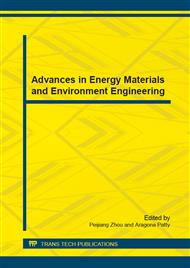[1]
Global wind energy, Global wind report: Annual market update 2013, Brussels, Belgium. July (2014).
Google Scholar
[2]
S. U. Offiah and P. E. Ugwuoke F. C. Odo, Weibull distribution-based model for prediction of wind potential in Enugu, Nigeria, Advances in applied science research, vol. 3, pp.1202-1208, (2012).
Google Scholar
[3]
E. Abbasi and D. Nguyen Huu K. Strunz, DC microgrid for wind and solar power integration, IEEE Journal of emerging and selected topics in power electronics, vol. 2, pp.115-126, (2014).
DOI: 10.1109/jestpe.2013.2294738
Google Scholar
[4]
J. A. Ferreira, B. B. Jensen, A. Abrahamsen, K. Atallah and R. A. McMahon H. Polinder, Trends in wind turbine generator systems, IEEE Journal of emerging and selected topics in power electronics, vol. 1, pp.174-185, (2013).
DOI: 10.1109/jestpe.2013.2280428
Google Scholar
[5]
C. Chancham, M. Landry and Y. Gagnon J. Waewsak, An analysis of wind speed distribution at Thasala, Nakhon Si Thammarat, Thailand, Journal of sustainable energy & environment, vol. 2, pp.51-55, (2011).
DOI: 10.1016/j.egypro.2014.07.071
Google Scholar
[6]
I. Usta Y. M. Kantar, Analysis of wind speed distributions: Wind distribution function derived from minimum cross entropy principles as better alternative to Weibull function, Energy conversion and management, vol. 49, no. 5, pp.962-973, (2008).
DOI: 10.1016/j.enconman.2007.10.008
Google Scholar
[7]
A. Feijóo D. Villanueva, Wind power distributions: a review of their applications, Renewable and sustainable energy reviews, vol. 14, p.1490–1495, (2010).
DOI: 10.1016/j.rser.2010.01.005
Google Scholar
[8]
E. Fernandez M. Carolin Mabel, Estimation of energy yield from wind farms using artificial neural networks, IEEE Transactions on energy conversion, vol. 4, pp.459-464, (2009).
DOI: 10.1109/tec.2008.2001458
Google Scholar
[9]
G. Mazor M. Huleihil, Wind turbine power: the betz limit and beyond, advances in wind power, in Advances in wind power: Dr. Rupp Carriveau, 2012, p. Chapter 1.
DOI: 10.5772/52580
Google Scholar
[10]
U. B. Gunturu C. A. Schlosser, Characterization of wind power resource in the United States, Atmospheric, Chemistry and Physics, vol. 12, pp.9687-9702, (2012).
DOI: 10.5194/acp-12-9687-2012
Google Scholar
[11]
F.C. Odo G.U. Akubue, Comparative Assessment of Three Models for Estimating Weibull Parameters for Wind Energy Applications in a Nigerian Location, International Journal of Energy Science, vol. 2, no. 1, pp.22-25, (2012).
Google Scholar
[12]
P. Gipe, Wind power renewable energy for home, farmand business: Chelsea Green Publishing, (2004).
Google Scholar
[13]
A. C. Brett S. E. Tuller, The characteristics of wind velocity that favor the fitting of a weibull distribution in wind speed analysis, Journal Application Meteorologic, vol. 23, pp.124-134, (1984).
DOI: 10.1175/1520-0450(1984)023<0124:tcowvt>2.0.co;2
Google Scholar


